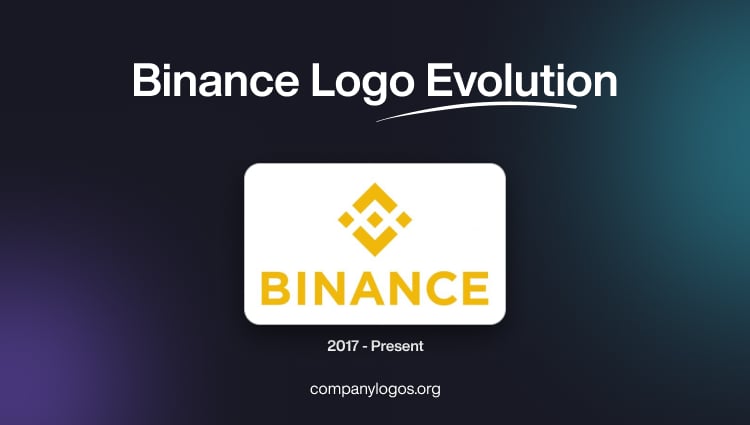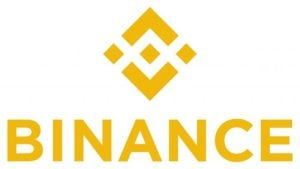
Binance is inarguably the largest cryptocurrency trade platform in the world. Founded in 2017, it offers a secure wallet to the users to store and trade crypto. It also offers its platform to trade in cryptocurrencies, such as Ethereum or Bitcoin. Its features include a fast-trading engine, peer-to-peer trading, futures, spot trading, options, and minimal fees. The company also provides Binance Card (allows users to spend cryptocurrency in physical transactions) and Binance Academy (an educational tool for cryptocurrency and blockchain enthusiasts).
The Binance logo is a distinctive visual mark in the world of cryptocurrency. It blends geometric symbolism with deep reference to trading, blockchain, and the brand’s core identity. The single logo has remained consistent since the inception of the company in 2017 and it reflects the rapid rise of Binance. The article deals with the Binance logo, among other details of the company.
The Genesis of the Binance Logo (2017 – Present)
The one and only logo till date of Binance was introduced by the company in 2017. It consists of a graphical emblem and the wordmark. The minimalist emblem comprises fragmented triangles and rhombuses in yellow and white. To the right of it appeared the brand name in uppercase written using a bold sans-serif typeface.
The letters of the wordmark have straight cuts and distinct contours. The typeface is similar to Lost & Foundry FS Cattle and Hops and Barley Clean 3b. The logo is designed in yellow to convey energy, happiness, progress, and movement.

The Elements of the Binance Logo
Font
The wordmark of the Binance logo is written using a clean sans-serif font that suggests reliability, global access, and transparency.
Colour
The colour palette of the Binance logo comprises yellow and white to maximise visibility and to imbue the logo with a sense of modernity and energy.
The History of Binance
Binance was founded in July 2017 by Changpeng Zhao (CZ) and Yi He. The name was derived by combining “Binary” and “Finance” to reflect its mission of building a financial system based on digital assets. To launch the platform, Binance conducted an Initial Coin Offering (ICO) and raised around $15 million through the issuance of its own token, Binance Coin (BNB). Initially, BNB offered trading fee discounts but later evolved into the backbone of the Binance ecosystem.
The exchange entered the market during the height of the 2017 crypto boom and, within just six months, became the largest cryptocurrency exchange in the world by trading volume. This was due to the platform’s low fees, wide selection of trading pairs, and user-friendly interface. Facing evolving regulations in different countries, Binance shifted its base several times in its early years. For instance, it moved operations from China to Japan and eventually to Malta.
Between 2018 and 2020, Binance expanded rapidly beyond spot trading. It launched Binance Labs as an incubator for blockchain startups, Binance Academy as a free educational platform, and Binance Launchpad for token offerings through Initial Exchange Offerings (IEOs). It also introduced Binance DEX on its own Binance Chain. At the same time, it launched Binance Futures and lent products to enter the DeFi-like space.
In September 2020, Binance unveiled the Binance Smart Chain (BSC), which was a blockchain compatible with Ethereum. Offering faster and cheaper transactions, Ethereum quickly became a hub for DeFi projects, NFT applications, and blockchain gaming.
By 2021, Binance had cemented itself as the leading global exchange and processed billions in daily trading volume. However, its meteoric rise drew heavy regulatory scrutiny from governments in the UK, Japan, Germany, the US, and other regions. The scrutiny was regarding the company’s compliance with anti-money-laundering standards.
In response, Binance strengthened its compliance framework. It hired ex-regulators, enforced stricter Know Your Customer (KYC) requirements, and built global compliance teams. In February 2022, Binance rebranded its blockchain ecosystem as the BNB Chain to emphasise decentralization while keeping BNB at the core of its ecosystem.
The company faced a major turning point in November 2023, when founder CZ stepped down as CEO after reaching a settlement with U.S. regulators over compliance violations. He admitted lapses in anti-money-laundering controls and agreed to pay substantial fines. As a result, Richard Teng, Binance’s Global Head of Regional Markets and a former Singaporean regulator, took over as CEO.
Despite this leadership shift and legal challenges, Binance retained its position as the largest cryptocurrency exchange in the world. It continued to expand services such as futures and spot trading, staking, savings, crypto payment cards, NFT marketplaces, and infrastructure through the BNB Chain.
Binance is a dominant force in the digital asset industry, and serves millions of users across more than 100 countries. In less than a decade, it has grown from a small startup launched during the ICO wave of 2017 into a global crypto powerhouse. It has shaped the industry through innovation, accessibility, and ecosystem building. While its journey has been marked by both rapid success and regulatory hurdles, Binance continues to play a central role in bridging traditional finance with the future of blockchain-driven digital finance.
Interesting Facts About Binance
- Binance became the world’s largest cryptocurrency exchange by trading volume in just six months after its launch in July 2017. This was a record-breaking rise in the financial sector.
- The name Binance is a blend of “Binary” and “Finance”, which symbolises its mission to merge digital technology with financial services.
- Binance Coin (BNB) was originally launched to give users trading fee discounts. Today, BNB powers the BNB Chain, which is used for payments, staking, DeFi, and more. These make Binance one of the largest cryptocurrencies in the world by market cap.
- For years, Binance operated without an official global headquarters. It had moved its base across multiple countries like China, Japan, and Malta to adapt to regulations. This “borderless” identity became one of its trademarks, though it has since been working on clearer jurisdictional structures.
- Binance serves over 150 million users worldwide. It offers trading access to hundreds of cryptocurrencies and supports dozens of fiat currencies.
- Launched in 2020, the Binance Smart Chain (BSC) quickly became one of the most used blockchains in the world. It hosted thousands of DeFi apps, NFTs, and blockchain games due to its speed and low transaction costs.
- Through Binance Academy, the exchange provides free blockchain and crypto education to millions of people globally. This makes Binance Academy one of the largest open learning resources in the industry.
- Binance has partnered with high-profile organizations and events, including Cristiano Ronaldo for NFTs, Formula 1 (Alpine team sponsorship), and even TikTok influencers. It has thus blended finance with global pop culture.
- Binance has often stepped in during crises. For example, it offered $10 million in donations to help Ukraine in 2022 and created charity initiatives through the Binance Charity Foundation.
- Founder Changpeng Zhao (CZ), who was once one of the most influential figures in crypto, stepped down as CEO in November 2023 after U.S. regulatory settlements. His successor, Richard Teng, now leads the exchange into its next era.
Finally
The Binance logo’s evolution reflects the founding values of the exchange as well as the central themes of the broader crypto community. These include binary trading, connectivity, and the pursuit of fairness and transparency in digital finance.